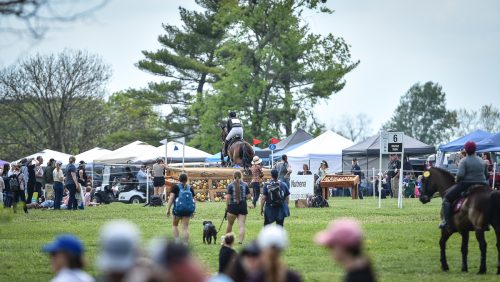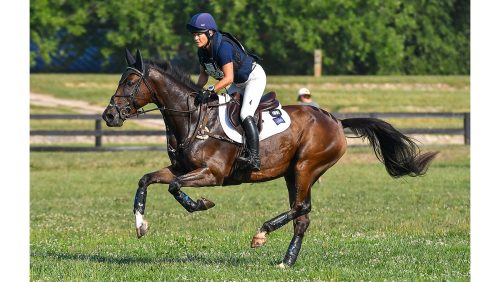Will Coleman took to Facebook on April 29 after the Land Rover Kentucky Three-Day Event to comment on the 15 penalties he and Tight Lines were assigned for missing a flag on cross-country.
The Fédération Equestre Internationale introduced this new flag rule in 2019. Article 549.2 states: “A Horse is considered to have missed a flag (15 penalties) if the Horse jumps the dimension of the obstacle and the majority of the Horse’s body passes through the flags. This means that some part of the body is not inside the flags (e.g. one shoulder, or one shoulder and part of one hip).”
The rule specifies that if the horse’s body goes through the flags but not all of its legs, then that would be considered clear. Further language states that only official video will be allowed as evidence when determining the type of penalty a horse incurred.
The 2019 Land Rover Kentucky Three-Day Event was the first five-star run with the new rule. Coleman picked up his penalties at 11A, a skinny brush chevron in the second water.
“I respect the difficulty the ground jury had in determining whether or not to assess the penalty,” Coleman said in his Facebook post. “When you watch the live feed video, I can understand, to a degree, where they are coming from in saying the horse’s hind end was outside the plane of the flag. That said, I don’t feel that you can really see where the hind end is in relation to the flags from that angle.”
You can watch Coleman’s full cross-country video on USEF Network here. The issue occurs at 4:30 on the video.
In addition to the livestream, the FEI has its own official video footage from cameras specifically set to assist in fence judging.
“Conversely, when you watch the head-on video, it’s clear that the horse’s neck, shoulders, and hips clearly pass through the flags in a straight line,” Coleman said. “His left hind leg slid outside the flags, but only after he makes contact with the jump, the force of which torqued his body slightly. It was a hard call. I was hopeful, because I thought it was obvious that the horse was making an honest effort to jump the fence, and the head-on video supported that.”
ADVERTISEMENT
Coleman and Tight Lines were one of four pairs to navigate Derek di Grazia’s cross-country course inside the optimum time. They had no jumping penalties elsewhere on course. Coleman and “Phish” also turned in a double-clear show jumping round on Sunday to end up in 13th place overall. Had they not been assigned the 15 penalties, Coleman would have finished on his dressage score in fifth place.
Video footage courtesy of Kourtney Korczak:
David O’Connor, the chair of the FEI Eventing Committee, was part of the team that wrote the new language for the 15-penalty rule.
“The problem we were trying to solve in the beginning is there have been multiple occasions at big events where a horse has gotten its head, neck and shoulder through a flag but never jumped the fence,” O’Connor said. “So the first point of the rule was to make sure the horse jumped the fence. The second part was that under the old rule, 50 penalties were assigned for missing a flag, and riders thought that was a bit extreme, so we actually reduced it from 50 to 15.”
The rule has seen action at lower levels this spring and was cause for discussion after its interpretation by officials at events in the United Kingdom. Kate Walls started an online petition on April 22 calling to remove the rule, and it’s already garnered almost 4,000 signatures.
“We are sending out clarifications on the rule this week ahead of [the Mitsubishi Motors Badminton CCI5*-L (England)], because at a couple of events in England there were officials who thought if a flag got dislodged 15 penalties should be assigned, and that was never the intent of the rule,” O’Connor said. “It’s not an automatic 15 penalties for hitting a flag, and the fence judge still needs to make the first call; that right hasn’t been taken away. When in doubt, the doubt should go to the rider. If it’s unclear, it goes to the rider.”
O’Connor was not on the ground jury that made the call in Coleman’s case, but he said he thinks they made the right call. Members of the jury did not respond to requests for comment.
“In my case, I think there was no question my horse tried to jump between the flags. Did I ride it perfectly? Absolutely not,” Coleman said. “Was the distance too long? Yes. There were lots of awkward rides there throughout the day. Did the horse jump it well? No, he is not the scopiest, and he scraped over it, and it was hairy as hell. That’s eventing. It ain’t all roses.
ADVERTISEMENT
“But punishing this horse for trying his absolute hardest to do the right thing in that moment just seems wrong, especially when the actual intent of the rule is to penalize combinations who are trying to NOT negotiate the fence and are simply wrangled between the flags,” Coleman continued. “Unequivocally, that was not the case here. It was as honest an effort on the part of the horse as you can get. If you want to punish me for having one dicey fence on an 11 minute 5* track, the rest of which the horse made look like child’s play in one of only four double clear rounds, then give me a yellow card for not riding well enough.”
Coleman was also bothered by the lack of support from the U.S. Equestrian Federation.
“As an American, I was dismayed by the fact that not one single person from my federation came to my defense or aid as I protested this penalty,” Coleman said. “One would think that trying to secure a top-5 finish for an American rider at America’s only 5* competition would be a priority for US Eventing.
“I can tell you that protesting something like this by yourself, as a rider, is difficult,” Coleman continued. “I can think of no other country who would not have stood behind their rider in this circumstance, even though I doubt it would have made any difference in the end. The US Eventing Team, to me, looks more like a club, and I am obviously not in it. I’m just fine with that too.”
The USEF Director of Sport Will Connell responded to Coleman’s comments in a statement Monday afternoon.
“Following Will Coleman’s cross-country round at the LRK3DE, he did not contact any members of the U.S. Eventing Team leadership to discuss the penalties, or about contacting the Ground Jury. Therefore, no one was in a position to accompany him to speak to the Ground Jury,” Connell said. “As Kentucky CCI5*-L is an individual competition, any appeal made by the athletes does not have to go through a Chef d’Equipe; athletes can approach Ground Juries directly.
“Further to the decision being made, both the U.S. Eventing Technical Advisor (Chef d’Equipe) and USEF Sport Director did consult the Ground Jury and/or Technical Delegate and both felt reassured that due diligence had been applied and the correct decision made in regards to the penalty,” Connell continued. “USEF fully supports the actions taken by the Ground Jury and the Technical Delegate in reviewing all of the incidents during cross-country at the LRK3DE. It is USEF’s understanding that the evidence presented from the additional cameras on course was compelling that the 15 penalties was correctly applied.”
Erik Duvander, USEF’s eventing performance director, declined to comment further on the matter.
“At the end of the day, I can live with the ruling,” Coleman said. “Regardless of the scoreboard, I know what my horse did this weekend, and I’m very proud. We will have other chances, and I look forward to those.”















